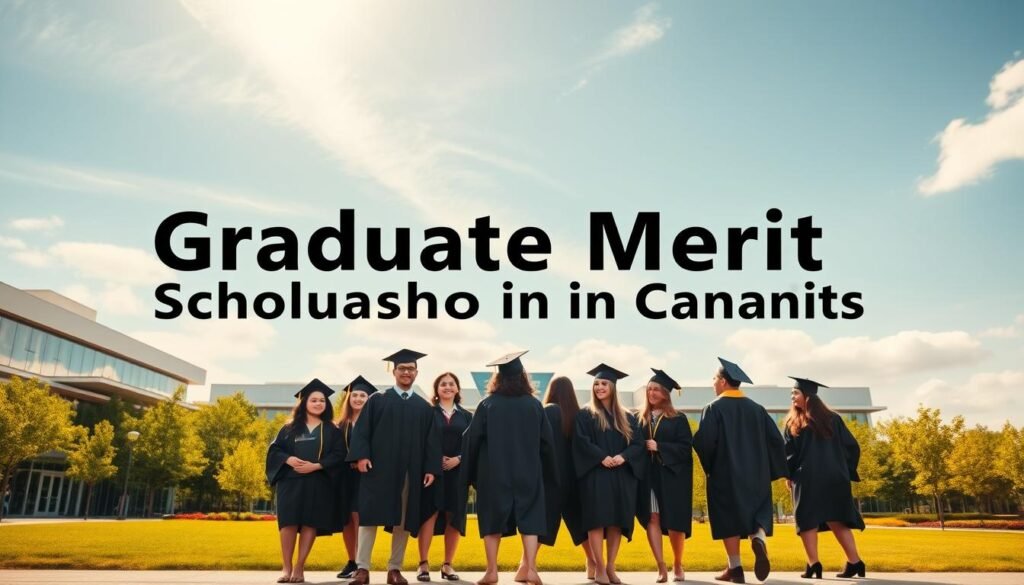
Explore Graduate Merit Scholarships Canada for Graduates

You’re about to get a clear, service-focused overview of award options across canada graduate pathways. Find the right fit for your studies and research goals without sifting through dozens of pages.
The flagship CGS M award provides $27,000 for one year and has a firm deadline of December 1 at 8:00 pm ET. Applications go through the Research Portal, which opens in early September.
Tri-agencies CIHR, NSERC and SSHRC jointly run these programs so your application aligns with subject mandates. You’ll also learn what information to gather, common timelines, and where to find the official page and institution instructions.
By the end of this article, you’ll know which awards match your program and level, how funding compares, and the next steps to plan a strong application.
- Why choose Canada’s graduate merit scholarships for your studies
- graduate merit scholarships Canada: what’s available now
- Canada Graduate Scholarships - Master’s (CGS M): value, eligibility, deadlines
- How to apply for CGS M through the Research Portal
- Selection criteria you’ll be assessed on
- Inclusive excellence: Indigenous and Black student researcher funding
- Ontario Graduate Scholarship (OGS): value, eligibility and how to be nominated
- Doctoral pathways: Canada Graduate Scholarships - Doctoral and more
- After you apply: notifications, conditions of award and holding your funding
- Related opportunities to extend your research and training
- Ready to strengthen your application and meet the next deadline
Why choose Canada’s graduate merit scholarships for your studies
Strong, institution‑administered funding gives you space to focus on study, mentorship, and impact. A national award supports training across health research, natural sciences and engineering, and social sciences and humanities.

With tri‑agency guidance, awards aim to cultivate skills, creativity and real-world impact. That backing helps you protect research time and reduce financial pressure so you can dig deeper into your thesis or project.
- Lift your profile with prestige and stronger positioning for future opportunities.
- Access mentorship, lab networks, and funding for travel and research costs.
- Combine award support with institutional training and responsible research practices.
| Benefit | What it means | Practical impact |
|---|---|---|
| Protected time | Dedicated support for your research | Faster progress on proposals and data collection |
| Professional development | Workshops and supervisor networks | Stronger skills for labs and future employers |
| Mobility & collaborations | Eligibility for supplements and travel | More international partnerships and impact |
graduate merit scholarships Canada: what’s available now
Here’s a concise map of current award options, the agencies behind them, and whom they fund.

The core national awards are managed by three agencies that match your field.
Tri‑agency awards at a glance
CIHR covers health research. NSERC supports natural sciences and engineering and engineering research. SSHRC funds social sciences and humanities.
The CGS M program supports up to 3,298 students a year across these disciplines. Institutions receive allocations and accept applications through the Research Portal, so you apply via your university.
Provincial programs and institutional awards
Provincial options like the Ontario Graduate Scholarship complement federal awards. Institutional awards are managed at the unit level and reflect discipline priorities.
| Award | Admin agency | Disciplines | Notes |
|---|---|---|---|
| CGS M | CIHR / NSERC / SSHRC | Health; natural sciences; social sciences | Institution-based; 3,298 awards/year |
| OGS (example) | Provincial / University | All disciplines | Campus nomination; complements federal awards |
| Institutional fellowships | University | Discipline‑specific | Allocated by unit; varies by program |
Canada Graduate Scholarships - Master’s (CGS M): value, eligibility, deadlines
Learn the core facts about the CGS M its value, who can apply, and the key deadline to plan for. This award supports full‑time research at eligible institutions and links your field to the correct agency.

Funding value and tenure
The CGS M provides $27,000 for 12 months. It is a one‑year, non‑renewable award meant to fund intensive research activity.
Who may apply
Applicants must be Canadian citizens, permanent residents, or Protected Persons by the December 1 deadline. You must be admitted to or applying for a full‑time, research‑oriented program at a listed institution with a CGS M allocation.
Maintain a first‑class average in your last two years, as defined by your host institution. Candidates who previously held a master’s‑level tri‑agency award are ineligible.
Eligible fields and timing
Map your study to the right agency: CIHR for health research, NSERC for natural sciences and engineering, and SSHRC for social sciences and humanities. Awards are tenable only at eligible Canadian institutions.
Note the key date: submit via the Research Portal by December 1 before 8:00 pm ET. The portal opens in early September so you can prepare transcripts, references and a research summary.
| Feature | Details | Action for you |
|---|---|---|
| Value | $27,000 for 12 months (non‑renewable) | Plan a one‑year research budget |
| Eligibility | Citizens/PR/Protected Persons; full‑time research program; first‑class average | Confirm status and transcripts early |
| Fields | Health research; natural sciences; social sciences & humanities | Choose correct agency and match your proposal |
| Deadline | December 1, 8:00 pm ET via Research Portal | Start application in September; meet internal institutional dates |
How to apply for CGS M through the Research Portal
Start early and stay organised. The Research Portal opens in early September, so begin by creating your Canadian Common CV (CCV) and linking it to your portal application. Keep entries current: education, publications, awards and contributions.
Creating your Canadian Common CV and starting your application
You’ll build your CCV on the official CCV site, then create or access an application in the Research Portal. Upload concise research summaries and list referees clearly so reviewers can verify your record.
Selecting institutions with allocations and respecting internal timelines
You may apply to up to three institutions that hold CGS M allocations. Pick places with strong supervision fit and check each faculty's internal deadlines and nomination rules.
Submitting complete applications and avoiding last‑minute portal delays
Prepare a submission checklist: transcripts, referee contacts, CCV link, and PDFs with clean file names. The application cut‑off is December 1 before 8:00 pm ET; late submissions are not accepted.
- Submit at least 48 hours early to avoid heavy portal traffic.
- Verify file sizes and formats to prevent upload errors.
- Contact your faculty graduate office early for program‑specific forms and approvals.
| Action | When | Tip |
|---|---|---|
| Create CCV | Early September | Keep entries concise and dated |
| Choose institutions | September–October | Match supervisor and agency |
| Submit via Portal | By Dec 1, 8:00 pm ET | Submit 48+ hours early |
For full application details and the official competition page, visit the official CGS M competition page.
Selection criteria you’ll be assessed on
Understanding the assessment grid helps you present evidence exactly where reviewers look. The competition uses a clear weighting so you can map your dossier to each area.
Academic excellence weighting and indicators
Weight: 50%. Reviewers look at transcripts, awards, course load and any relative standing your institution provides.
Research potential and proposed study
Weight: 30%. Emphasize originality, feasibility and clear methods. Show how your proposed research advances knowledge and training in your field.
Personal characteristics and interpersonal skills
Weight: 20%. Provide evidence of leadership, communication and project management from labs, volunteer roles or publications.
- Brief referees on which criterion they should address.
- Structure statements to mirror the three areas for quick scoring.
- Use DORA-aligned outputs (data, preprints, community engagement) as evidence.
| Criterion | Weight | What to supply |
|---|---|---|
| Academic excellence | 50% | Transcripts, class rank, awards, course load |
| Research potential | 30% | Research summary, methods, prior experience |
| Personal characteristics | 20% | Leadership examples, teamwork, communication |
Quick self‑audit: score each area out of ten, then strengthen the weakest with concrete evidence or better referees before submission.
Inclusive excellence: Indigenous and Black student researcher funding
This section outlines designated supports that increase funding access for Indigenous and Black student researchers. It explains supplements, reserved awards and how to self‑identify in the portal.
Indigenous Scholars Awards and $5,000 supplement
Successful CGS M Indigenous recipients may receive a $5,000 supplement in addition to the $27,000 award. Students on an alternate list might be offered a $27,000 Indigenous Scholars Award plus the $5,000 top‑up, subject to funding and affirmation rules.
Reserved awards for Black student researchers
Each agency sets aside up to 20 additional CGS M awards for Black student researchers who self‑identify and consent. This creates more pathways to core funding and builds a more inclusive training environment.
Self‑identification, documentation and support
You indicate self‑ID within the Research Portal application. Agencies use that data to enable priority offers. You must follow the affirmation policy for Indigenous citizenship or membership before accepting any specific award.
"These measures reflect a tri‑agency commitment to equity, diversity and inclusion and practical support for student success."
| Measure | Who it helps | Typical benefit |
|---|---|---|
| Indigenous supplement | Indigenous recipients | $5,000 top‑up |
| Indigenous Scholars Award | Alternate Indigenous list | $27,000 + $5,000 (subject to funds) |
| Reserved Black awards | Self‑identified Black researchers | Up to 20 additional awards per agency |
- Work with your graduate unit to reflect inclusive offers in your file.
- Contact campus Indigenous or Black student support for documentation help and mentorship.
- Expect inclusive offer communications alongside standard results and follow policy notes before acceptance.
Ontario Graduate Scholarship (OGS): value, eligibility and how to be nominated
OGS funding provides reliable, year-by-year support that departments nominate through unit-level competitions. Each award is $5,000 per session and tenable for one academic year. You can receive up to $15,000 across three sessions.
Value and duration
The standard value is $5,000 per session. Most students hold it for one year, and units nominate candidates annually.
Who is eligible
Domestic citizens, permanent residents and Protected Persons qualify. A capped number of international students with valid study permits may also be nominated. You must be full‑time in an eligible program.
Unit process, GPA and limits
Selection happens at the faculty or unit level. Typical GPA expectations are an A‑average in the last two years, though units can grant exceptions for strong cases.
- Maximum support: two years at master’s, four at doctoral, six years lifetime across government awards.
- You cannot hold OGS simultaneously with tri‑agency awards or another OGS.
- Results often appear mid‑July at some universities; follow your unit’s deadlines and use the School of Graduate Studies form to apply.
| Feature | What it means | Action |
|---|---|---|
| Value | $5,000/session, up to $15,000 | Plan annual budget |
| Eligibility | Domestic and select international | Check study permit status |
| Concurrency | Not with tri‑agency or another OGS | Coordinate award timing |
Doctoral pathways: Canada Graduate Scholarships - Doctoral and more
If you’re aiming for a PhD, know which national awards run in the fall and how they align with your plans.
The CGS D is now the harmonized doctoral competition across the three agencies, replacing older routes like Vanier for many applicants. Expect institutional calls in early September and some campuses list a competitive internal deadline.
CGS D competition timelines and tri‑agency adjudication
Adjudication begins at the unit level, moves to institutional review, then to agency panels. This layered review tests fit to discipline and training potential.
Track internal deadlines, the national competition cut‑offs, and referee submission windows so your applications are complete before the portal closes.
Pair CGS D with other awards to strengthen funding across your doctoral program. Notable examples include Killam Doctoral Scholarships, Affiliated Fellowships Doctoral, Fulbright, DAAD and the Trudeau Foundation.
"Stage applications so deadlines don’t clash: submit early, align references, and highlight leadership in your research plan."
| Award | Value / Tenure | Typical Deadline | Role |
|---|---|---|---|
| CGS D | $xx,xxx / 3–4 years (varies) | Fall institutional & national rounds | Primary national doctoral funding |
| Killam | $xx,xxx / 1–2 years | Varies by university (fall/winter) | Complement CGS D; prestige |
| Fulbright / DAAD | Travel & study allowances | Country-specific rounds | International study & collaborations |
| Trudeau / Affiliated | Higher-value fellowships | Staggered, often fall | Leadership and public impact focus |
After you apply: notifications, conditions of award and holding your funding
After submission, you’ll move into the notification and acceptance phase. Offers for the CGS M appear in the Research Portal starting April 1. Alternate offers can arrive through January 31 of the next year.
Results in the Research Portal and alternate offers window
Check the portal regularly. When you receive an offer, accept or decline promptly so units can manage alternates. If you are on an alternate list, expect decisions during the extended window and follow guidance from your faculty.
Location of tenure, concurrent award rules and policy compliance
Awards are normally held at the offering institution. Requests to change the location of tenure may be approved in exceptional circumstances submit approvals early through your graduate office.
You cannot concurrently hold another tri‑agency award with CGS M, except the CGS‑MSFSS. Follow the Tri‑agency Research Training Award Holder’s Guide for conduct, progress reporting and payment rules.
"Accept offers quickly, keep your registration current, and work with your graduate office to manage any mid‑year changes."
| Topic | What you must do | Key note |
|---|---|---|
| Offer timing | Monitor Research Portal from Apr 1 | Alternate offers until Jan 31 |
| Holding institution | Confirm award location with faculty | Transfers require approval |
| Concurrent funds | Avoid other tri‑agency awards (CGS‑MSFSS exception) | Non‑compliance can stop payments |
| Policy compliance | Follow award holder guide; keep records | Retain documentation for audits |
Practical tips: keep proof of registration, notify payroll if fees change, and request leaves or supervisor changes early to avoid interruptions in funding.
Look beyond core awards to find supplements and external programs that extend your research reach. Many holders add mobility funding or discipline‑specific top‑ups to build international links, buy specialised equipment, or fund fieldwork.
The CGS‑Michael Smith Foreign Study Supplements (CGS‑MSFSS) supports award holders who plan short international placements. It funds travel, living costs and research collaboration while you hold award support.
Notable agency and department supplements
Agency and departmental competitions include:
- CMHC‑SSHRC Housing Research Scholarship
- Canadian Forest Sector Workforce Diversity supplement
- CIHR Strategic Master’s Award and Environment and Climate Change Canada supplements
- DND MINDS Scholarship and discipline supplements like Systematics Research and Impact Assessment
Many of these are field‑specific, especially across sciences engineering and health research. Align your proposal to the supplement’s aims and list a clear host or collaborator for mobility awards.
How to synchronise supplements with your main award
Confirm eligibility early, check internal nomination steps, and match timelines. Some competitions open in September or follow tight quotas.
| Opportunity | Typical benefit | Action for you |
|---|---|---|
| CGS‑MSFSS | Mobility funding for international placements | Plan host lab and milestones; apply early |
| Discipline supplements | Top‑ups for methods, fieldwork or equity initiatives | Check agency page and department lists |
| External doctoral fellowships | Multi‑year funding (Killam, Fulbright, DAAD, Trudeau) | Map your longer‑term plan beyond the one‑year award |
"Confirm funds availability and submission windows early; coordination with your institution makes the process smooth and compliant."
Practical tip: work with your supervisor and graduate office to time applications so you can hold award support and any supplements without breaching concurrency rules.
Ready to strengthen your application and meet the next deadline
Take a simple, scheduled approach now so you meet key portal and unit dates. The Research Portal opens in early September and the CGS M deadline is December 1 at 8:00 pm ET. Plan your work in weekly blocks and leave time for uploads and referee replies.
Book a meeting with your faculty supervisor to align your research plan and ensure you can hold award requirements. Note OGS unit calls and typical mid‑July results so your applications do not clash.
Before you submit, confirm applicants must complete the CCV, attach transcripts, and fill all portal fields. Submit 48+ hours early to avoid last‑minute issues.
Apply with confidence. You now have the information and a compact process to draft, polish and submit strong applications that secure funding this year and set up your phd or degree study with solid support.
If you want to know other articles similar to Explore Graduate Merit Scholarships Canada for Graduates you can visit the category Scholarships.






Leave a Reply